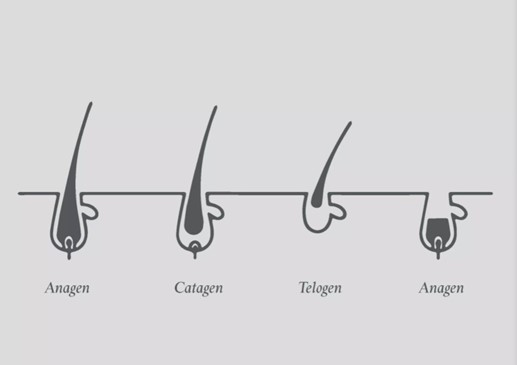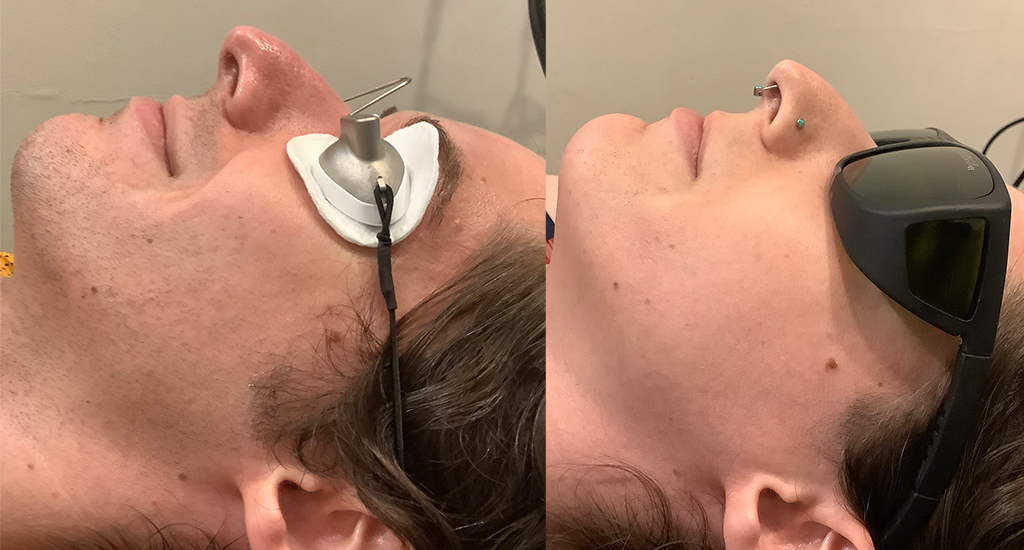Going Through a Phase: The Relationship Between Hair Growth Phases and Laser Hair Removal
Why does laser hair removal take several sessions to remove unwanted hair? Wouldn’t a great laser get rid of all of the hair at once?
These are questions we get asked daily and truly require a longer answer to thoroughly explain the many facets of how laser hair removal works. So, let’s dive in and fully explore the hair removal process and describe the relationship between hair growth and laser hair removal.
In short, laser hair removal is only able to treat a fraction of hairs called “anagen hairs” at each session. In the anagen hair phase, hairs are physically attached to the blood source and are being nourished to grow and are “alive.” Because only a fraction of your hair will be in this anagen phase at the time of your treatment while some hairs remain dormant, we repeat the treatment numerous times. This ensures that we target all of the anagen hairs at every subsequent visit. To cycle through all of the anagen hair follicles and provide our clients with a significant hair reduction, it takes a minimum of 12 months of treatments for most people.
Power & Energy: A Progressive Hair Removal Plan
One of the most critical steps in laser hair removal is sending the correct dose of light energy (jcm2) to the hair bulb. At Luxe, we go by the “Goldilocks Approach” to administer the perfect amount of light energy – not too much energy nor too little energy, but just right! The laser sends a blast of light energy 2 mm below the skin in the dermis to destroy the stem cells that create the hair follicle.
In the beginning of a hair removal series, we must start with the least amount of energy to prevent overtreating, as there is a large chromophore (target) for the laser to attack. The laser’s target is melanin (hair color) and the laser requires a certain amount of hair density, as well. Terminal, thicker hairs are preferred over vellus baby hairs.
Towards the end of a series, we can safely use the highest amount of light energy, since there are fewer hairs and these hairs, at this point, will have become finer and thus the body will absorb less light energy. We increase energy at subsequent treatments to ensure the stem cells are neutralized. This energy increase is imperative for an efficacious treatment plan or the hairs will continue to grow and the treatment ultimately will fail.
Consistency is Key
The full spectrum of hair growth phases is as follows:
Anagen– During this phase, the cells in the root of your hair follicle are dividing rapidly and adding to the hair shaft, creating new growth. The hair is still attached to the blood supply and your body is actively nourishing this new follicle. During the anagen phase, the hair follicles are the most receptive to laser light because they are rich in protein (keratin) and melanin. Lasers work by targeting the melanin in the hair.
Catagen– The catagen phase is a short window of time after the anagen phase, where active growth ceases and the hair prepares itself to shed.
Telogen– After the brief catagen phase, the hair falls out (some people refer to this as exogen, the 4th phase) and the follicle rests for a certain period of time, depending on where the hair is located on your body. Eventually, the anagen phase recycles and new hair grows from that follicle.
Treatment pacing matters. Different areas of the body enter anagen growth stage at different times, meaning we must treat on a regimented schedule in accordance with the anagen hair cycles in order to achieve reduction.
If you stop and start treatments without taking the anagen hair phases into account, not only will we be in conflict with Candela’s optimal treatment protocols, but it may end up costing you additional treatments.
In a worst-case scenario where there has been a dramatic gap in your treatments, you’ll have to start over, as the stem cells may proliferate, creating new terminal hairs and putting us back at the beginning.
With every session, you will have less anagen hairs and, as a bonus, all phases of the hair (anagen, telogen and catagen) fall out between treatments, meaning you’ll look noticeably smoother between your laser hair removal appointments.

At Luxe Laser, we can provide you with several types of laser hair removal services. Our most popular services include facial hair removal, brazilian, and underarms as well as hair removal on the trunk, legs, and arms. Most areas of the body are able to be treated, as long as the hairs are terminal. The thicker the hairs, the better the results! Here is an anagen regrowth guideline of recommended treatment timelines depending on which areas are being treated.
Face & Neck: 4-week intervals.
Underarm & Bikini: 6-week intervals.
Trunk, Legs & Arms: 8-week intervals.
With each session, you will notice that there are fewer hairs in general, the hair growth rate will be decreased, the hair may thin and become finer and hairs may reduce in follicle count.
As your treatments progress, both your hair growth and the return to the anagen phase will slow down and sessions will need to be pushed out if you are experiencing no visible growth. The laser needs hairs in order to work!
Studying and understanding the hair growth cycle and respecting our body’s natural rhythm creates the best result possible for laser hair removal. Plenty of our competitors schedule treatments too close together. This benefits their schedule, moving clients in and out as quickly as possible, but it may not yield long-standing results.
While we understand the allure of a lightning-fast treatment timeline, it simply does not work for long term permanent hair reduction, as you will be missing anagen hair phases and require more treatments.
Contact Luxe Laser Today!
Searching for laser hair removal in Portland? Let us be your laser hair removal experts! We will optimize your treatments and help you become a hair detective so that you can make the most out of every service. Slow and steady wins the race to silky smooth skin! Call or text our Medspa in Portland at any time to book your first appointment.
